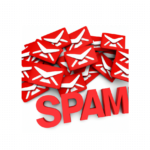Unlock the Mystery: 12 Common Reasons Why Your Emails Land in the Spam Folder
Email campaigns are the lifeblood of most industries. They are the major contributor to the billions of yearly emails sent worldwide. Most email campaigns are well planned, However, regardless of hours spent on design, content, and ROI predictions, they all have the same thing in common. Some emails go into the spam folder faster than a hot knife through butter.
Why, because everyone hates SPAM, and everyone is trying to control it.
and everyone is trying to control it.
For example, email programs can give the recipient the ability to:
- Create email rules so the next emails from the Suzie Cream Cheese factory automatically go into the SPAM folder.
- To easily mark a message as SPAM, thereby training their email program to always deliver this FROM address to the SPAM folder. And if it was marked by accident, the FROM address is still banned from their Inbox forever unless they change it.
- Use email filtering appliances such as Mimecast, or Barracuda, of which none of these is 100% accurate, Users noted “We have seen a vast increase in false positives and undetected malicious emails in our environment over time with barracuda.”
Aside from filters, human error, and email appliances, it seems everything concerning inbox delivery is designed to work against the email marketer.
Keep those messages out of the SPAM folder by:
- Using complete sender information– Avoid a sloppy email FROM field, caused by arbitrary characters, a nonsense sender address, or use of numbers. Use a real FROM address, and preferably continue to use the same one, so it becomes familiar to the receiver.
- Include a Physical Address in the message. Having a real address, even a PO box if needed for those home-based businesses, will show the recipient that the email comes from a real place. And it’s the law in most countries.
 Emailing your messages to opted-in subscribers. It takes time to acquire a list for email marketing. It may be tempting to rent, borrow, or buy email addresses but this isn’t recommended by most Email Service Providers. Instead, build your list organically with opted-in forms on your website, social media, and other marketing channels.
Emailing your messages to opted-in subscribers. It takes time to acquire a list for email marketing. It may be tempting to rent, borrow, or buy email addresses but this isn’t recommended by most Email Service Providers. Instead, build your list organically with opted-in forms on your website, social media, and other marketing channels.- Creating a good, catchy Subject line. There’s lots of advice on the Internet on how to create the preferred Subject Line, including web tools and AI Subject Line generators.
Avoid the use of all capitals, emojis, and punctuation marks. - Offering good content will keep them coming back. Effective email content is crucial for engaging, informing subscribers, and promoting your products or services. To achieve this, it is essential to consider your audience, the tone of your message, and the intended goal of your message. (and do not forget to check your spelling and grammar)
- Authentication, to prove you are who you say you are. Normally before an email is considered deliverable to the inbox by a receiving email server, it’s scrutinized, authenticated, and examined right along with the sender and their sender's reputation. Using authentication protocols (SPF, DKIM, BIMI, DMARC) validates that the email is sent from your domain and IP address. It’s less likely to be directed to the spam folder from the receiver's email server.
- Testing the internal links in your message. Always review the entire message, (have someone else read it over too) and test all the links to verify they work as expected. Make sure they are labeled correctly: When you have a link that said Digital Web Leprechauns, make sure goes there.
- Adding attachments. There’s been a steady increase in spam, malware emails, and phishing attempts in general. Sending attachments that are not expected, too big, or too many is never a good idea. (Just as a side note, our customers send attachments without issues, as they are assigned their own IP address, with up-to-date authentication protocols, and the attachments are expected by the recipients.)
- Cutting back on images. Don’t overcrowd your message with images. Be smart with your visual content, is should have a purpose. “A picture maybe worth 1,000 words”, but it can also trigger cues that this message is spam.
 Messaging the correct audience. When you have a big list that requires segments to deliver your messages, verify those segments are targeting the right recipients. When you accidentally send mustache remover coupons to your segment list of young ladies, you may elicit some unwanted unsubscribes.
Messaging the correct audience. When you have a big list that requires segments to deliver your messages, verify those segments are targeting the right recipients. When you accidentally send mustache remover coupons to your segment list of young ladies, you may elicit some unwanted unsubscribes.- Removing those unsubscribes and inactives on your active list. Inactive subscribers are ones who lost interest in your messages; taking no action on your emails as they have filtered your messages out of their virtual life. ( Put those aside for a re-engagement campaign) Emailing inactive members can harm deliverability. With today’s tools, ESPs who notice you are sending messages to an address that never opens your message will start to route your messages to the spam folder.
- Leaving an easy pathway to unsubscribe. Publicize easy-to-use unsubscribe instructions. The unsub process should be automatic, without the caveat of waiting up to 10 days to leave. Do not require a series of clicks to opt-out. You know how you feel when you want to stop receiving emails from a list. Test your unsubscribe link. Make sure it works.
There are several reasons why emails may end up in the spam folder. Reasons include filters, email appliances and human error. As an email marketer, it’s crucial to follow best practices to avoid it. Email delivery to the inbox is more likely to occur when you use complete sender information, create good content, have a great subject line, use email authentication, test internal links and avoid unexpected attachments. And as always test your emails before you send, for optimal results.


Comments
Post a Comment